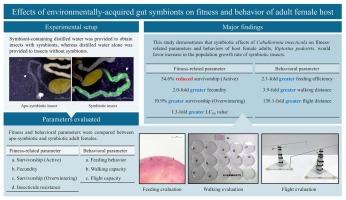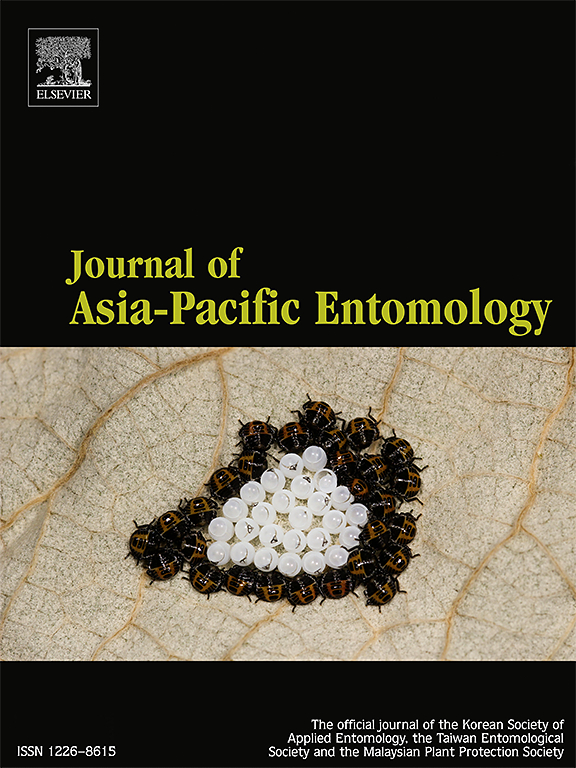环境获得性肠道共生体对成年雌寄主步行Riptortus(半翅目:盲蝽科)适应度和行为的影响
IF 1.3
3区 农林科学
Q3 ENTOMOLOGY
引用次数: 0
摘要
豆虫Riptortus stris(半翅目:豆虫科)每一代都从土壤环境中获得属于Burkholderiaceae的共生细菌。其共生细菌的有益作用主要体现在未成熟阶段,而对成虫生物学的影响尚未得到充分研究。本研究研究了肠道共生体卡瓦隆菌(cabalalleronia)对雌性步行田鼠成虫健康和行为特征的影响。首先,共生菌对成虫的存活率有不利影响,在成虫羽化后60天,共生菌和非共生菌的成虫存活率分别降至86.7%和56.7%。尽管共生雌虫寿命缩短,但在此期间,共生昆虫的繁殖力平均比非共生昆虫高2.0倍。我们还在实验室条件下评估了越冬存活率,发现共生雌虫的存活率明显高于非共生雌虫。其次,行为分析表明,共生性的步行街鼠通过每次进食更多的大豆而表现出更高的摄食效率。对于行走和飞行能力,共生产生显著的流动性比非共生的。特别是,共生雌性在4小时内的平均飞行距离为1.3公里,是非共生雌性的138.1倍。最后,共生雌虫对有机磷杀虫剂菲硝硫磷的敏感性较低,在72.4 ppm和92.4 ppm时,共生雌虫的致死浓度分别为50% (LC50)。综上所述,我们的研究表明,雌性步行鼠的共生效应有利于寄主种群的增长。本文章由计算机程序翻译,如有差异,请以英文原文为准。

Effects of environmentally-acquired gut symbionts on fitness and behavior of adult female host, Riptortus pedestris (Hemiptera: Alydidae)
Bean bug, Riptortus pedestris (Hemiptera: Alydidae), acquires its symbiotic bacteria belonging to family Burkholderiaceae from soil environments in every generation. Beneficial effects of its symbiotic bacteria have been demonstrated mainly with immature stages of R. pedestris, while remaining their effects on adult biology largely unexplored. In this study, we investigated effects of the gut symbiont, Caballeronia insecticola, on fitness and behavior traits of female R. pedestris adults. First, the symbiotic bacteria exerted adverse effects on survivorship, with which survival rates decreased to 86.7 % and 56.7 % in apo-symbiotic and symbiotic females, respectively, at 60 days after adult emergence. Despite a reduced longevity of symbiotic females, the fecundity of symbiotic insects was on average 2.0-fold greater than that of apo-symbiotic ones during this period. We also evaluated overwintering survivorship in laboratory conditions and found that symbiotic females exhibited significantly higher survivorship than that of apo-symbiotic ones. Second, behavioral assays demonstrated that symbiotic R. pedestris displayed enhanced feeding efficiency by consuming higher amounts of soybean per feeding attempt. For both walking and flight capacity, symbiosis yielded significant increases in mobility than apo-symbiotic ones. In particular, symbiotic females flew on average 1.3 km over 4 h, which was 138.1-fold greater than apo-symbiotic ones. Finally, symbiotic females were less susceptible to an organophosphate insecticide, fenitrothion, yielding the lethal concentrations for 50 % (LC50) at 72.4 ppm and 92.4 ppm for apo-symbiotic and symbiotic groups, respectively. Taken together, our study demonstrates that the symbiotic effects on female R. pedestris would favor the host population growth.
求助全文
通过发布文献求助,成功后即可免费获取论文全文。
去求助
来源期刊

Journal of Asia-pacific Entomology
Agricultural and Biological Sciences-Insect Science
CiteScore
2.70
自引率
6.70%
发文量
152
审稿时长
69 days
期刊介绍:
The journal publishes original research papers, review articles and short communications in the basic and applied area concerning insects, mites or other arthropods and nematodes of economic importance in agriculture, forestry, industry, human and animal health, and natural resource and environment management, and is the official journal of the Korean Society of Applied Entomology and the Taiwan Entomological Society.
 求助内容:
求助内容: 应助结果提醒方式:
应助结果提醒方式:


